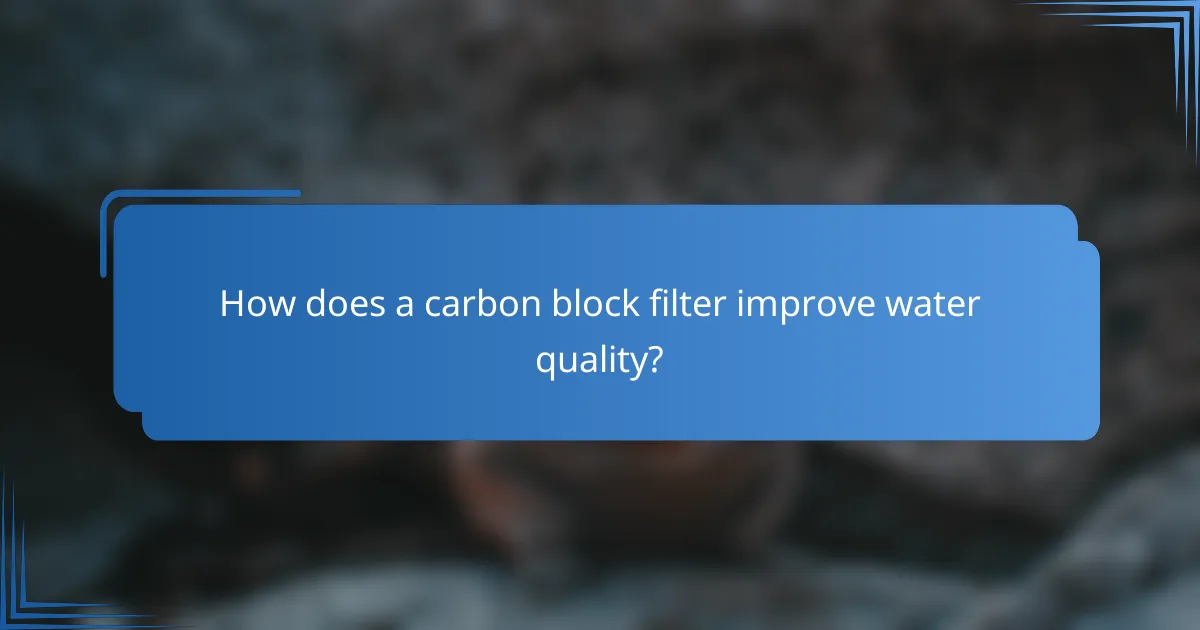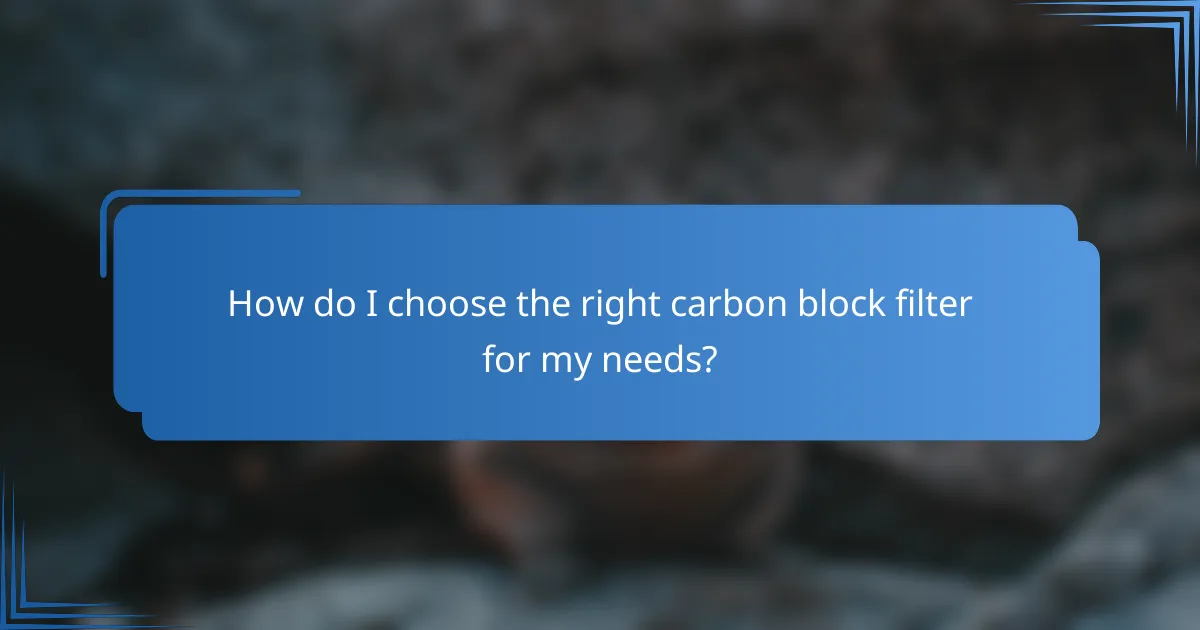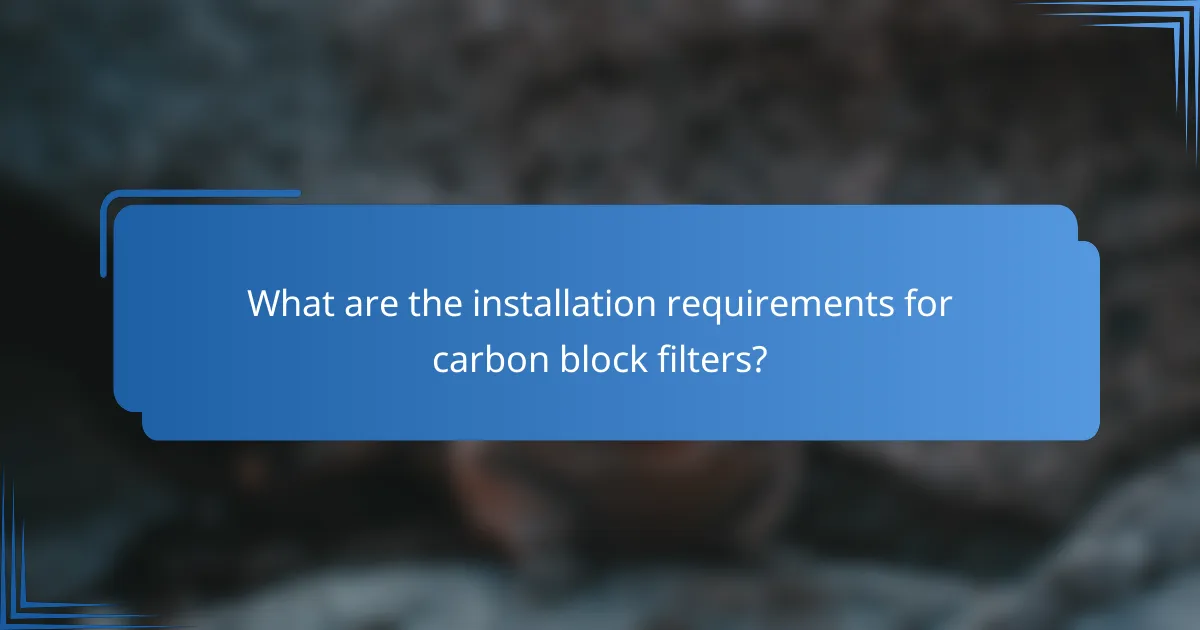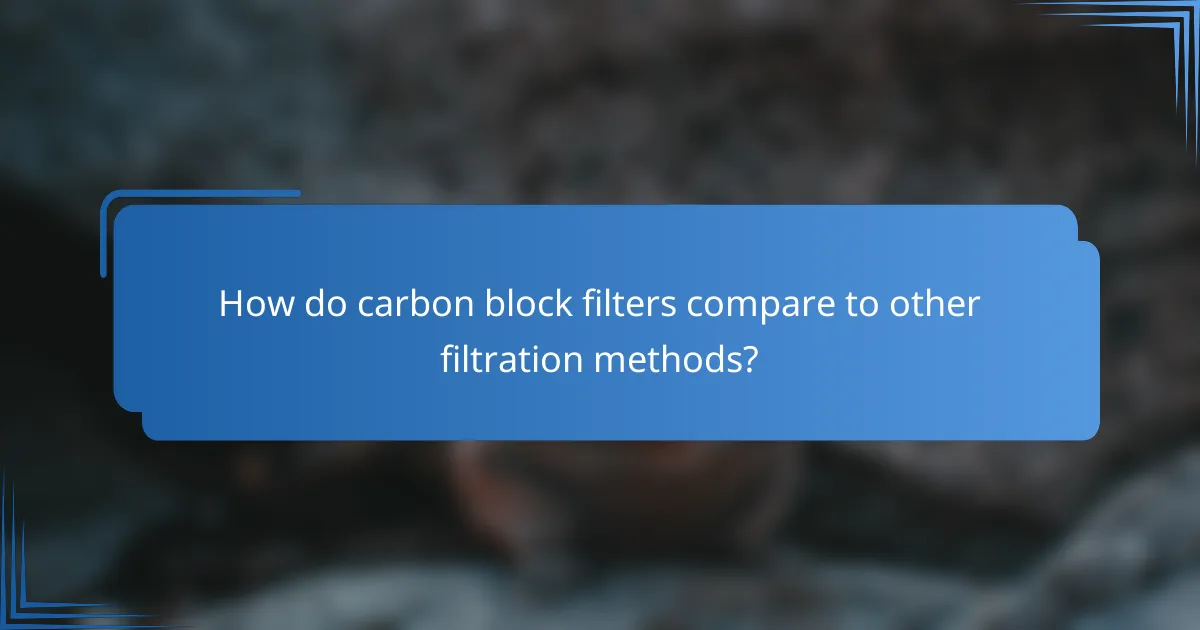A carbon block filter is designed to enhance water quality by significantly reducing chlorine levels and improving taste. With its high capacity, this filter effectively handles larger volumes of water, making it an excellent choice for households with greater consumption needs.

How does a carbon block filter improve water quality?
A carbon block filter enhances water quality by effectively reducing contaminants like chlorine and improving taste. Through a process of adsorption, these filters capture impurities, resulting in cleaner, better-tasting water for everyday use.
Reduces chlorine levels
Carbon block filters significantly lower chlorine levels in tap water, which is commonly used as a disinfectant in municipal water supplies. By trapping chlorine molecules, these filters help eliminate the chemical’s harsh taste and odor.
In many regions, chlorine levels can vary widely, often ranging from 1 to 4 mg/L. A good carbon block filter can reduce these levels to below 0.5 mg/L, making the water safer and more palatable.
Enhances taste and odor
By removing chlorine and other volatile organic compounds, carbon block filters greatly enhance the taste and smell of drinking water. This improvement is particularly noticeable in areas where water has a strong chemical flavor or odor.
Many users report a fresher, cleaner taste, which encourages increased water consumption. This can be beneficial for overall health, as staying hydrated is essential.
Removes sediment and impurities
In addition to chlorine, carbon block filters effectively remove sediment and various impurities, including rust, dirt, and some heavy metals. This filtration process helps ensure that the water is not only cleaner but also clearer.
Regular maintenance and timely replacement of the filter are crucial, as clogged filters can reduce flow rate and effectiveness. It’s advisable to replace carbon block filters every 6 to 12 months, depending on usage and water quality.

What are the benefits of using a high-capacity carbon block filter?
A high-capacity carbon block filter offers significant advantages, including reduced chlorine levels and improved taste in drinking water. These filters can handle larger volumes of water, making them ideal for households with higher consumption needs.
Longer lifespan between replacements
High-capacity carbon block filters typically last longer than standard filters, often providing several months of use before needing replacement. This extended lifespan is due to their ability to handle larger amounts of contaminants, which means less frequent changes are required.
For example, while a standard filter might need replacing every two to three months, a high-capacity option can last up to six months or more, depending on water quality and usage. This not only saves time but also reduces waste from discarded filters.
Increased flow rate
These filters are designed to maintain a higher flow rate, ensuring that water is delivered quickly without sacrificing filtration quality. This is particularly beneficial in busy households where multiple taps may be in use simultaneously.
With a high-capacity carbon block filter, users can expect a steady flow of filtered water, often exceeding 2 gallons per minute. This efficiency means less waiting time for clean water, making it convenient for cooking, drinking, and other household needs.
Cost-effective solution
Investing in a high-capacity carbon block filter can be more cost-effective in the long run. Although the initial purchase price may be higher than standard filters, the longer lifespan and reduced frequency of replacements lead to overall savings.
Additionally, by improving water quality and taste, these filters can reduce the need for purchasing bottled water, further decreasing household expenses. Over time, the savings from fewer replacements and less bottled water can add up significantly, making this a smart choice for budget-conscious consumers.

Which brands offer the best carbon block filters?
Several brands are recognized for their high-quality carbon block filters, which effectively reduce chlorine and improve water taste. Notable names include Brita, APEC Water Systems, and iSpring, each offering unique features and capacities to suit various needs.
Brita carbon block filters
Brita is a well-known brand that provides carbon block filters designed to enhance water quality by reducing chlorine taste and odor. Their filters typically last for several months, depending on usage, and are compatible with various pitcher and faucet systems.
When choosing Brita filters, consider the model that best fits your water consumption and filtration needs. The standard filters are effective for everyday use, while advanced options may offer additional features like improved contaminant reduction.
APEC Water Systems filters
APEC Water Systems specializes in reverse osmosis systems that often include carbon block filters as part of their multi-stage filtration process. These filters are effective at removing chlorine and other impurities, resulting in cleaner, better-tasting water.
APEC filters are typically designed for higher capacity and longer lifespan, making them suitable for households with greater water demands. Ensure you check the specific model for its filtration capabilities and replacement schedule.
iSpring filters
iSpring offers a range of carbon block filters that are often integrated into their reverse osmosis systems. These filters excel at reducing chlorine and other contaminants, significantly improving the taste and safety of drinking water.
When selecting iSpring filters, consider the system’s overall filtration stages and the specific contaminants you wish to target. Their filters are known for durability and efficiency, making them a reliable choice for home water filtration.

How do I choose the right carbon block filter for my needs?
To choose the right carbon block filter, consider your specific water quality needs, the filter’s capacity, and how well it integrates with your existing systems. Prioritize filters that effectively reduce chlorine and enhance taste while meeting your household’s water consumption demands.
Consider filter capacity
Filter capacity refers to the amount of water a carbon block filter can treat before needing replacement. Most filters have a capacity ranging from a few hundred to several thousand liters, depending on usage. Assess your household’s daily water consumption to select a filter that can handle your needs without frequent changes.
For example, if your family uses around 300 liters of water daily, a filter with a capacity of 1,500 liters would last approximately five days before needing replacement. Always check the manufacturer’s specifications for guidance on capacity and replacement intervals.
Evaluate filtration performance
Filtration performance is crucial for ensuring the carbon block filter effectively reduces chlorine and improves taste. Look for filters that meet NSF/ANSI standards for chlorine reduction, which indicates they have been tested for performance. Filters that can remove contaminants like sediment, volatile organic compounds (VOCs), and heavy metals are also beneficial.
Some filters may offer additional features, such as multi-stage filtration, which enhances overall water quality. Reading customer reviews and expert ratings can provide insights into the effectiveness of specific models.
Check compatibility with existing systems
Before purchasing a carbon block filter, ensure it is compatible with your current water system, whether it’s a faucet-mounted filter, under-sink unit, or whole-house system. Compatibility affects installation ease and overall performance. Verify the filter’s connection type and size to avoid issues during installation.
If you have a reverse osmosis system, check if the carbon block filter can be integrated without affecting water pressure or flow rates. Consulting with a plumbing professional can help clarify compatibility and installation requirements, ensuring you make the right choice for your home.

What are the installation requirements for carbon block filters?
Installing carbon block filters typically requires standard plumbing connections, adequate space under sinks, and easy access for maintenance. Ensuring these factors are met will help optimize the filter’s performance and longevity.
Standard plumbing connections
Carbon block filters generally connect to existing plumbing systems using standard fittings, such as 1/4-inch or 3/8-inch tubing. It’s essential to check compatibility with your current setup, as some filters may require additional adapters or connectors. A proper seal is crucial to prevent leaks.
Space considerations under sinks
When installing a carbon block filter, ensure there is sufficient space under the sink for the unit and any associated components, like storage tanks or additional filters. Typically, a clearance of at least 12 inches in height and 6 inches in width is recommended. Measure the area beforehand to avoid installation issues.
Maintenance access
Easy access for maintenance is vital for the longevity of carbon block filters. Ensure that the filter is positioned in a way that allows for straightforward replacement of cartridges and inspection of connections. Regular maintenance should be performed every 6 to 12 months, depending on water quality and usage.

How do carbon block filters compare to other filtration methods?
Carbon block filters are effective at reducing chlorine and improving taste, making them a popular choice for water filtration. Compared to other methods like reverse osmosis, they offer a simpler installation and maintenance process while still delivering high-capacity filtration.
Carbon block vs. reverse osmosis
Carbon block filters and reverse osmosis (RO) systems serve different purposes in water purification. While carbon block filters primarily target chlorine, taste, and odor, RO systems remove a broader range of contaminants, including heavy metals and dissolved solids.
One key difference is that carbon block filters typically have a higher flow rate, allowing for quicker access to filtered water. In contrast, RO systems may produce water at a slower rate due to the multi-stage filtration process, which can take several hours to fill a tank.
When choosing between the two, consider your specific needs. If taste and chlorine reduction are your main concerns, a carbon block filter may suffice. However, if you require comprehensive purification, an RO system might be the better option, despite its higher cost and maintenance requirements.
